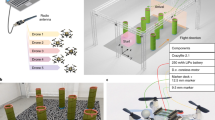Abstract
Exploration and mapping of unknown environments is a vibrant topic of research in the robotics community. Virtual potential fields have been used in prior research largely for spatial distribution, path planning and pattern formation. These fields involve the use of functions, often grounded in physics, to generate virtual potential fields that may be used to guide robots. It is the contention of this paper that a similar ‘virtual reactive forces’ method may be used for exploration and mapping, in combination with the already established occupancy grid method. This process involves the use of multiple virtual forces, based on the fundamental forces of nature, to guide robots in collision avoidance, exploration, and mapping. This paper compares the effectiveness of this method on heterogeneous and homogeneous swarms.
Access this chapter
Tax calculation will be finalised at checkout
Purchases are for personal use only
Similar content being viewed by others
References
Barnes, L., Fields, M., Valavanis, K.: Unmanned ground vehicle swarm formation control using potential fields. In: Mediterranean Conference on Control and Automation, MED 2007, pp. 1–8. IEEE (2007)
Elfes, A.: Using occupancy grids for mobile robot perception and navigation. Computer 22(6), 46–57 (1989)
Jacoff, A.: Guide for evaluating, purchasing, and training with response robots using DHS-NIST-ASTM international standard test methods, March 2009
Khatib, O.: Real-time obstacle avoidance for manipulators and mobile robots. Int. J. Robot. Res. 5(1), 90–98 (1986)
McCook, C.J., Esposito, J.M.: Flocking for heterogeneous robot swarms: a military convoy scenario. In: 2007 Thirty-Ninth Southeastern Symposium on System Theory, pp. 26–31. IEEE (2007)
Mondada, F., Bonani, M., Raemy, X., Pugh, J., Cianci, C., Klaptocz, A., Magnenat, S., Zufferey, J.C., Floreano, D., Martinoli, A.: The e-puck, a robot designed for education in engineering. In: Proceedings of the 9th Conference on Autonomous Robot Systems and Competitions, vol. 1, pp. 59–65. IPCB: Instituto Politécnico de Castelo Branco (2009)
Reif, J.H., Wang, H.: Social potential fields: a distributed behavioral control for autonomous robots. Robot. Auton. Syst. 27(3), 171–194 (1999)
Spears, W.M., Spears, D.F., Hamann, J.C., Heil, R.: Distributed, physics-based control of swarms of vehicles. Auton. Robots 17(2–3), 137–162 (2004)
Wiegand, R.P., Potter, M.A., Sofge, D.A., Spears, W.M.: A generalized graph-based method for engineering swarm solutions to multiagent problems. In: Runarsson, T.P., Beyer, H.-G., Burke, E., Merelo-Guervós, J.J., Whitley, L.D., Yao, X. (eds.) PPSN 2006. LNCS, vol. 4193, pp. 741–750. Springer, Heidelberg (2006). doi:10.1007/11844297_75
Zhou, X.S., Roumeliotis, S.I.: Multi-robot slam with unknown initial correspondence: the robot rendezvous case. In: 2006 IEEE/RSJ International Conference on Intelligent Robots and Systems, pp. 1785–1792. IEEE (2006)
Author information
Authors and Affiliations
Corresponding author
Editor information
Editors and Affiliations
Rights and permissions
Copyright information
© 2017 Springer International Publishing AG
About this paper
Cite this paper
Bridgwater, T., Winfield, A., Pipe, T. (2017). Reactive Virtual Forces for Heterogeneous and Homogeneous Swarm Exploration and Mapping. In: Gao, Y., Fallah, S., Jin, Y., Lekakou, C. (eds) Towards Autonomous Robotic Systems. TAROS 2017. Lecture Notes in Computer Science(), vol 10454. Springer, Cham. https://doi.org/10.1007/978-3-319-64107-2_20
Download citation
DOI: https://doi.org/10.1007/978-3-319-64107-2_20
Published:
Publisher Name: Springer, Cham
Print ISBN: 978-3-319-64106-5
Online ISBN: 978-3-319-64107-2
eBook Packages: Computer ScienceComputer Science (R0)




